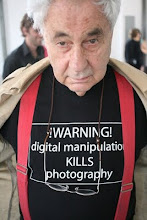The “Sequences” were successful shortly after the first ones were made. They were first exhibited in 1972 in the Noord-Brabants Museum in ’s-Hertogenbosch, the Netherlands. Followed by exhibitions in London, Paris and New York. The “Sequences” sold very well to give the financial independence to focus on producing this characteristic form of photography full time.
“Sequences” are about awareness. And how to make different and surprising interpretations of reality. It is about how reality is possibly related to ourselves.
In 1985 the making of the “Sequences” was abandoned. The motivation for this decision was to avoid getting into repeating ideas. To become the own epigone.
“Sequences” were made from 1970 to 1985.
First in the Netherlands. Later in France and Morocco. Next in the USA. And eventually exclusively in Baja California, Mexico.
Making the “Sequences” was a solitary activity. Long periods of time were spent in areas were no human presence could be noticed.
Michel Szulc-Krzyzanowski: The Early Sequences 1977-1982
September 4 – October 18, 2008
Reception: Thursday, September 4, 6-8pm
Robert Mann Gallery opens the fall exhibition season with a suite of vintage photographic works by Dutch conceptual artist Michel Szulc-Krzyzanowski. Living out of a trailer in Baja California, Mexico, Szulc-Krzyzanowski engaged in a rigorous study of possibilities opened by combining multiple frames of images into sequences. David Travis, former curator of photography at the Art Institute of Chicago, writing about Szulc-Krzyzanowski’s Sequences in 1984 explains,
[W]e can imagine him to be a magician, who plays tricks on our perceptions with his photographic sleights of hand in order to loosen the strict conventions of our imagination and in the end entertains us. But even in his play he uses the appearance of simultaneity to make the illusion work.
Greatly ahead of his time, Szulc-Krzyzanowski began his sequences in the early 1970s. Embracing the potential for multiple frames to be read together, he deployed a variety of conceptual strategies in these works: alternately invoking the passage or apparent suspension of time. Szulc-Krzyzanowski consistently plays off the structural basis of the frame; particular sequences seem to ignore the parameters of individual exposures—a paradoxical conceit as the printing displays the edges of each negative. In such instances the Sequences are decidedly non-cinematic in their embrace of flatness and simultaneity. While these descriptions might imply otherwise, change is a constant in the Sequences, most often illusively describing movement by maintaining single elements as a constant visual referent—sometimes a part of the artist’s body, an object in the foreground or the distant horizon line.
The meaningful thrust of the Sequences derives from their exploration of perception and reception. But they also exhibit a playful inquisitiveness that aligns Szulc-Kryzanowski with contemporaries such as John Baldessari. Szulc-Krzyzanowski’s work represents a process of discovery. In perceiving his images, we cannot help be aware of the performance inherent in their production. We can imagine the artist—the camera almost an extension of his body—on the beach, interrogating perceptual and aesthetic boundaries. Again, in David Travis’s words, “It is not so much an experience during time that [Szulc-Krzyzanowski] presents, but rather a conceptual experience concerning time.”
Michel Szulc-Krzyzanowski was born in 1949 in Oosterhout, The Netherlands. His work has been exhibited internationally since the early 1970s and is included in numerous major public collections, including the Art Institute of Chicago; the Centre Pompidou, Paris; the Museum of Modern Art, New York; the San Francisco Museum of Modern Art; and the Stedelijk Museum.
View Michel Szulc-Krzyzanowski: The Early Sequences 1977-1982 online at www.robertmann.com beginning September 4, 2008.
Michel Szulc-Krzyzanowski – Sequenties
CODA Museum | 29.01 t/m 28.05.2017
CODA Museum presenteert het werk van Michel Szulc-Krzyzanowski van 29 januari tot en met 28 mei 2017 in de tentoonstelling Sequenties; een bloemlezing uit eigen collectie.
Krzyzanowski maakt in de jaren zeventig naam als een van de grondleggers van zwart-wit sequentiefotografie (fotoreeksen) maar omdat deze werkwijze hem geen nieuwe inzichten meer oplevert, besluit hij na ruim 15 jaar te stoppen met deze vorm van fotografie. Sinds 2016 maakt hij echter weer sequenties. Ditmaal in kleur. De tentoonstelling in CODA Museum laat een aantal reeksen zien waarmee Krzyzanowski in de jaren zeventig wereldfaam verwierf.
Over Michel Szulc-Krzyzanowski
Michel Szulc-Krzyzanowski (Oosterhout, 1949) gebruikt zijn fotocamera om existentiële vragen over het leven en zijn bestaan te onderzoeken. De gespannen thuissituatie uit zijn jeugd is van grote invloed geweest op zijn persoonlijke groei en ontwikkeling als beeldend kunstenaar. Hij omschrijft zichzelf na de lagere school als een wispelturige jongen. Op de Westerhelling, een jongenskostschool in Nijmegen, wordt hij lid van de fotoclub en raakt hij bevriend met beeldend kunstenaar Teun Hocks. Hocks had in 2015 een overzichtstentoonstelling van geënsceneerde fotografie in CODA Museum. Zowel Hocks als Szulc-Krzyzanowski zijn met werk vertegenwoordigd is in de CODA collectie.
Krzyzanowski
De sequentie als zoektocht
Door het maken van sequenties, beeldreeksen van twee of meer foto’s, probeert de twintiger Szulc-Krzyzanowski zijn plaats in de wereld te bevragen en te bevestigen. In zijn fotoseries wordt de realiteit van verschillende kanten of in verschillende fases onderzocht en getoond. Veelal gefotografeerd op verlaten stranden in Nederland, Frankrijk, Marokko, de Verenigde Staten en Mexico, speelt Szulc-Krzyzanowski met tijd en beweging en ruimtelijke begrippen als veraf en dichtbij: hij ensceneert het beeld. Zo ontstaan intrigerende reeksen van foto’s die de beschouwer uitdagen om goed te kijken en na te denken over wat er nu precies te zien is. De zo universeel mogelijke invulling van zijn foto’s – een leeg strand, de zee, een steen, een anonieme schaduw van een hand of been – is niet toevallig. Iedere toeschouwer moet zich in zijn zoektocht kunnen herkennen. Zichtbaar of onzichtbaar, de mens staat echter centraal in het werk van Szulc-Krzyzanowski.












































Geen opmerkingen:
Een reactie posten